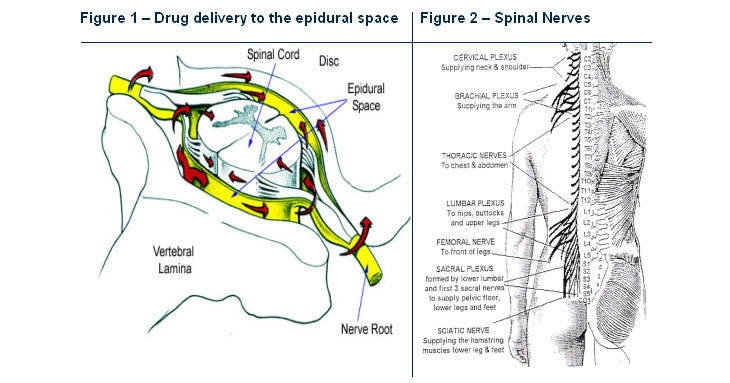Epidural and Nerve Root Injections for Pain Relief
Epidural and Nerve Root blocks are used to alleviate pain which is spinal in origin. The injection(s) used to deliver steroids (Depo Medrone - this is a slow release anti-inflammatory drug) and local anaesthetic (lignocaine or bupivacaine) into the epidural space and around the spinal nerve roots (see figure 1). The injections are given at different levels of the spine depending on the site of pain. Figure 2 shows the nerves and the area of the body they are associated with.
Epidurals
The aim of the epidural injection is to relieve leg pain called sciatica or arm pain called cervical brachialgia (due to nerve irritation or entrapment due to a prolapsed disc), which has not responded to more simple treatments (medication/physiotherapy). The goal of the injection is to provide enough relief for you to be able to continue with physical activity. The epidural injection appears to work by reducing the pain for long enough to allow the prolapsed disc to settle. Sometimes more than one injection may be required, if the symptoms return or persist. This can be repeated after one - two weeks.
- Lumbar epidurals are given for low back pain and or leg pain, hip and buttock pain.
- Thoracic epidurals are used to alleviate upper back pain, rib and chest wall pain.
- Cervical epidurals are used in the treatment of neck, shoulder and arm pain.
Nerve Root Injections
This is the introduction of local anaesthetic and steroid into the sheath around the nerve. This is undertaken when your Pain Consultant is aware of which nerve root or roots are the source of your pain. Nerve Root Blocks are usually undertaken when a nerve is thought to be inflamed by a disc pressing on it or by scarring after back surgery or due to arthritis from a nearby spinal joint and other less common causes.
Where and how is the procedure performed?
The procedure will take place in an X-ray theatre, to enable your doctor to place the injection at the appropriate level for your pain. Prior to the procedure the doctor will insert an intravenous line in order to access a vein. This will enable the nurse to give sedation if required for the procedure.
You will be asked to lie down on the X-ray table. A nurse will be with you at all times and you will be able to talk to her about any aspects of the procedure as it progresses. You will be offered sedation during the procedure. The sedation used is a combination of two drugs, which act in different ways. Fentanyl is used for pain relief and midazolam is a sedative to help you relax. The amount of sedation you require will depend on how well you tolerate the procedure. You will need to be awake enough to communicate with the doctor and nurses.
How is the procedure performed?
Once the needle is in place X-ray contrast medium is injected to ensure correct placement of the epidural injection or to outline the nerve root.
You need to be awake enough to report what you are feeling. The procedure can take 15-20 minutes to complete. During this time the nurse will be monitoring your heart rate, blood pressure and oxygen saturation. You may require oxygen by a facemask during the procedure.
What happens after the procedure?
You will be taken back to your room or recovery area on your bed where a nurse will monitor your progress and you will be able to rest for 30 minutes to an hour. You will then be offered something to eat or drink prior to getting up. Most patients are ready to go home an hour after the procedure is completed. You will not be able to drive yourself if you have had sedation. It is advisable to take things easy on the day of the procedure. You may find that you experience some pain for the following days after the procedure and it is expected that you will experience a reduction in your pain after this time.
When should I go back to work after the procedure?
You should be able to return to work the next day. If you are experiencing some pain around the injection sites you may wish to take a further day or two off work or at least ensure that your workload is not too heavy.
What are the risks?
The risks of any needle insertion are those of infection or bruising. Specific risks of these procedures is possible nerve injury and headache. These are rare complications.


